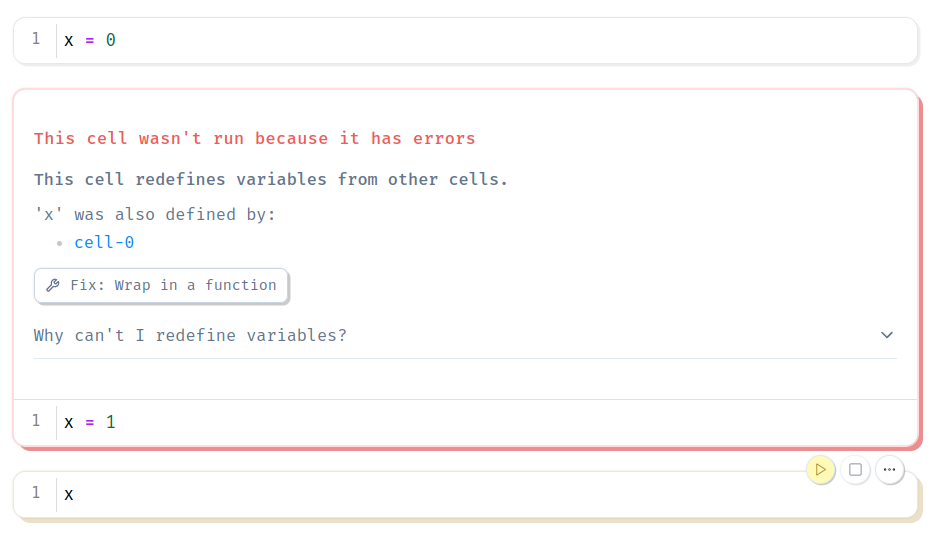Multiple definitions¶
You're probably on this page because you just saw an error like this one:

marimo raises this error when a variable is defined in multiple cells. In
this example, x was already defined, and the subsequent cell raised
an error when we tried to run it. In your case, perhaps your variable
is a loop variable (i), a dataframe (df), or a plot (fig, ax).
Watch our YouTube explainer
Why can't I redefine variables?¶
Understanding the error message. The error message tells you which other cells defined the multiply defined variable. You can click on the cell name, and marimo will highlight it.
Why can't I redefine variables? marimo guarantees that the code on the page
matches the outputs you see by determining a deterministic execution order on
cells; when one cell runs, marimo knows which others should run. But if two
cells defined x, and a third showed x, the output of the third cell would
be ambiguous, depending on which of the defining cells ran first (should it be
0 or 1?). That's a problem because it creates hidden state and hidden
bugs, and it's part of the reason why over 96% of
Jupyter notebooks on GitHub aren't reproducible.
What do I get in return?
By accepting this constraint on variables, marimo makes your notebooks:
- reproducible, with a well-defined execution order, no hidden state, and no hidden bugs;
- executable as a script;
- interactive with UI elements that work without callbacks;
- shareable as a web app, with far better performance than streamlit.
As a bonus, you'll find that you end up with cleaner, reusable code.
How do I fix this error?¶
You have a few options.
Use local variables¶
In marimo, variables prefixed with an underscore (_x or _i) are made local
to a cell, and can be redefined across multiple cells.
Use this in a pinch, but prefer encapsulating code in functions.
Encapsulate code in a function¶
Python provides local scope through functions: if the variable that was redefined is meant to be a temporary variable, then you can make it local to the cell by encapsulating the code in a function. If any of the cell's variables are not meant to be local, or are outputs meant to be displayed, just return them from the function.
In general, we recommend writing modular code with meaningful functions. But, in a pinch, just declare an anonymous function like this one to get a "local scope":
That's what clicking on the "Fix: Wrap in a function" button does. Note the function
_() is local to the cell.
Merge cells¶
Often you can simply merge the cells that define the same variable into a single cell.
To incrementally show outputs in the cell, use mo.output.append
or print().
Chain dataframe methods¶
When working with dataframes, instead of splitting up operations across multiple cells, chain operations in a single cell. This is especially ergonomic when using Polars, Daft, or other modern dataframe libraries that support lazy execution.